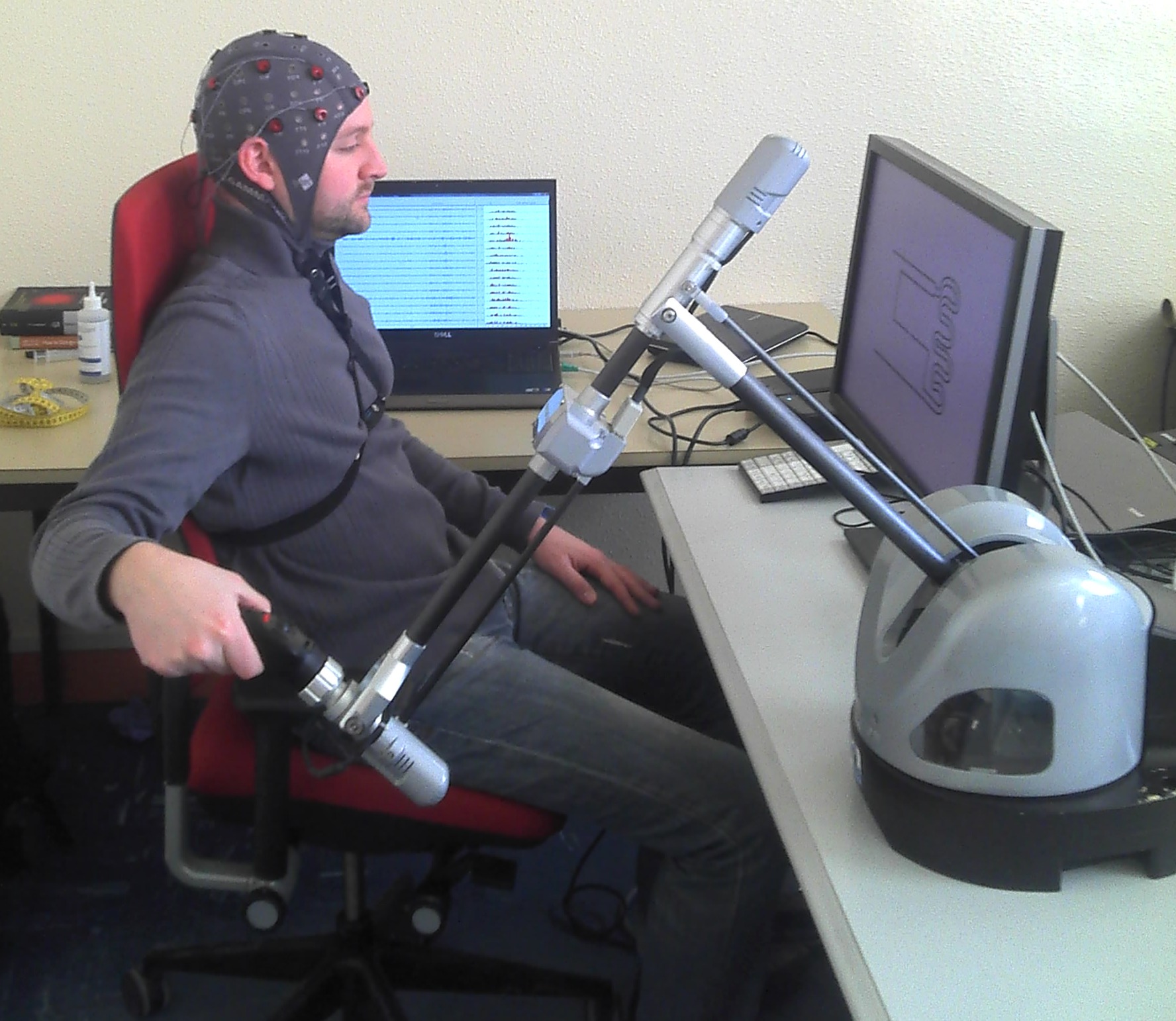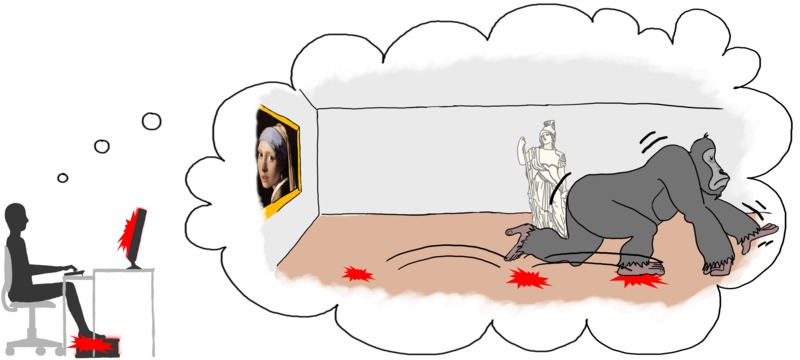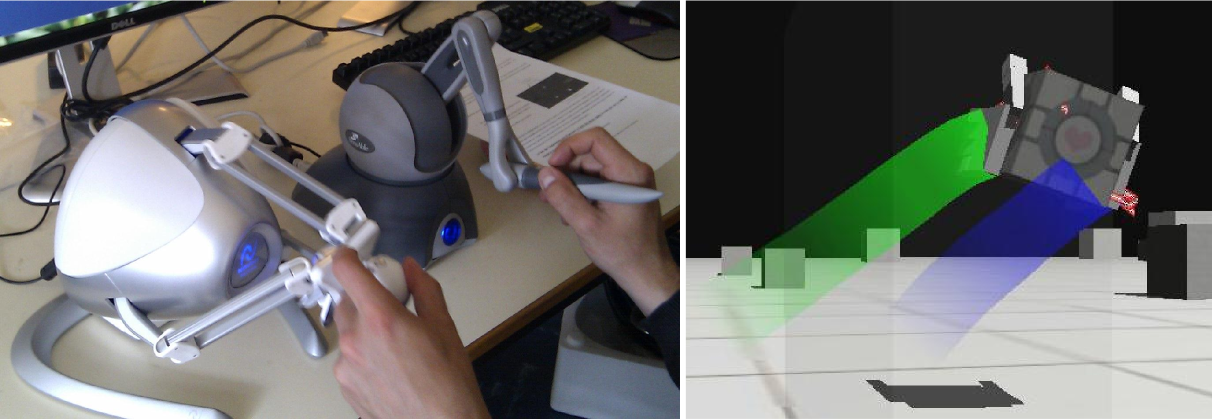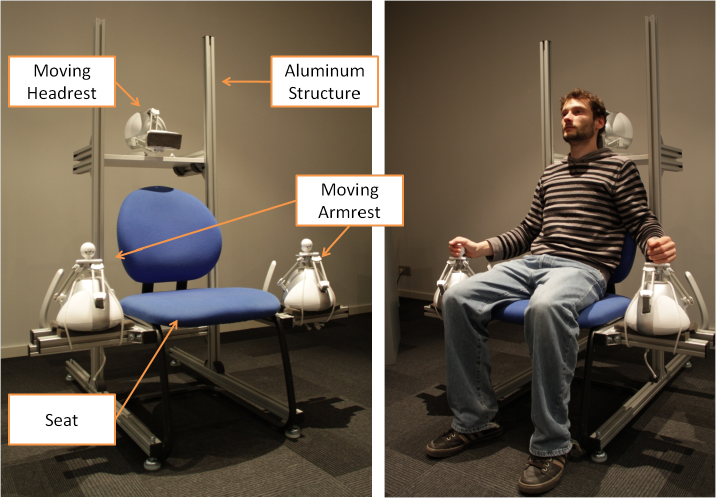Section: New Results
Multimodal immersive interaction
Immersive Archaeology
Participants : Bruno Arnaldi, Georges Dumont, Ronan Gaugne [contact] , Valérie Gouranton [contact] .
We propose a workflow of tools and procedures to reconstruct an existing archaeological site as a virtual 3D reconstitution in a large scale immersive system [35] . This interdisciplinary endeavor, gathering archaeologists and virtual reality computer scientists, is the first step of a joint research project with three objectives: (i) propose a common workflow to reconstruct archaeological sites as 3D models in fully immersive systems, (ii) provide archaeologists with tools and interaction metaphors to exploit immersive reconstitutions, and (iii) develop the use and access of immersive systems to archaeologists. In this context, we present [21] results from the immersive reconstitution of Carn's monument central chamber, in Finistere, France, a site currently studied by the Creaah archaeology laboratory. The results rely on a detailed workflow we propose, which uses efficient solutions to enable archaeologists to work with immersive systems. In particular, we proposed a procedure to model the central chamber of the Carn monument, and compare several softwares to deploy it in an immersive structure. We then proposed two immersive implementations of the central chamber, with simple interaction tools.
Novel 3D displays and user interfaces
Participants : Anatole Lécuyer [contact] , David Gomez, Fernando Argelaguet, Maud Marchal, Jerome Ardouin.
We describe hereafter our recent results in the field of novel 3D User Interfaces and, more specifically, novel displays and interactive techniques to better perceive and interact in 3D. This encloses: (1) Novel interactive techniques for interaction with 3D web content, and (2) A novel display for augmented 3D vision.
Novel interactive techniques for 3D web content
The selection and manipulation of 3D content in desktop virtual environments is commonly achieved with 2D mouse cursor-based interaction. However, by interacting with image-based techniques we introduce a conflict between the 2D space in which the 2D cursor lays and the 3D content. For example, the 2D mouse cursor does not provide any information about the depth of the selected objects. In this situation, the user has to rely on the depth cues provided by the virtual environment, such as perspective deformation, shading and shadows.
In [24] , we have explored new metaphors to improve the depth perception when interacting with 3D content. Our approach focus on the usage of 3D cursors controlled with 2D input devices (the Hand Avatar and the Torch) and a pseudo-motion parallax effect. The additional depth cues provided by the visual feedback of the 3D cursors and the motion parallax are expected to increase the users' depth perception of the environment.
The evaluation of proposed techniques showed that users depth perception was significantly increased. Users were able to better judge the depth ordering of virtual environment. Although 3D cursors showed a decrease of selection performance, it is compensated by the increased depth perception.
FLyVIZ : A novel display for providing humans with panoramic vision
Have you ever dreamed of having eyes in the back of your head? In [12] , we have presented a novel display device called FlyVIZ which enables humans to experience a real-time 360-degree vision of their surroundings for the first time.
To do so, we combined a panoramic image acquisition system (positioned on top of the user's head) with a Head-Mounted Display (HMD). The omnidirectional images are transformed to fit the characteristics of HMD screens. As a result, the user can see his/her surroundings, in real-time, with 360 degree images mapped into the HMD field of view.
We foresee potential applications in different fields where augmented human capacity (an extended field-of-view) could benefit, such as surveillance, security, or entertainment. FlyVIZ could also be used in novel perception and neuroscience studies.
Brain-Computer Interfaces
Participants : Anatole Lécuyer [contact] , Laurent George, Laurent Bonnet, Jozef Legeny.
Brain-computer interfaces (BCI) are communication systems that enable to send commands to a computer using only the brain activity. Cerebral activity is generally sensed with electroencephalography (or EEG). We describe hereafter our recent results in the field of brain-computer interfaces and virtual environments: (1) Novel signal processing techniques for EEG-based Brain-Computer Interfaces, and (2) Design and study of Brain-Computer Interaction with real and virtual environments.
Novel signal processing techniques for EEG-based Brain-Computer Interfaces
A first part of the BCI research conducted in the team is dedicated to EEG signal processing and classification techniques applied to cerebral EEG data.
To properly and efficiently decode brain signals into computer commands the application of efficient machine-learning techniques is required.
In [5] we could introduce two new features for the design of electroencephalography (EEG) based Brain-Computer Interfaces (BCI): one feature based on multifractal cumulants, and one feature based on the predictive complexity of the EEG time series. The multifractal cumulants feature measures the signal regularity, while the predictive complexity measures the difficulty to predict the future of the signal based on its past, hence a degree of how complex it is. We have conducted an evaluation of the performance of these two novel features on EEG data corresponding to motor-imagery. We also compared them to the gold standard features used in the BCI field, namely the Band-Power features. We evaluated these three kinds of features and their combinations on EEG signals from 13 subjects. Results obtained show that our novel features can lead to BCI designs with improved classification performance, notably when using and combining the three kinds of feature (band-power, multifractal cumulants, predictive complexity) together.
Evolutionary algorithms have also been increasingly applied in different steps of BCI implementations. In [29] , we could then introduce the use of the covariance matrix adaptation evolution strategy (CMA-ES) for BCI systems based on motor imagery. The optimization algorithm was used to evolve linear classifiers able to outperform other traditional classifiers. We could also analyze the role of modeling variables interactions for additional insight in the understanding of the BCI paradigms.
Brain-Computer Interaction with real and virtual environments
A second part of our BCI research is dedicated to the improvement of BCI-based interaction with real and virtual environments. We have first initiated research on Combining Haptic and Brain-Computer Interfaces.
|
In [22] , we have introduced the combined use of Brain-Computer Interfaces (BCI) and Haptic interfaces. We proposed to adapt haptic guides based on the mental activity measured by a BCI system. This novel approach has been illustrated within a proof-of-concept system: haptic guides were toggled during a path-following task thanks to a mental workload index provided by a BCI. The aim of this system was to provide haptic assistance only when the user's brain activity reflects a high mental workload.
A user study conducted with 8 participants showed that our proof-of-concept is operational and exploitable. Results showed that activation of haptic guides occurs in the most difficult part of the path-following task. Moreover it allowed to increase task performance by activating assistance only 59 percents of the time. Taken together, these results suggest that BCI could be used to determine when the user needs assistance during haptic interaction and to enable haptic guides accordingly.
This work paves the way to novel passive BCI applications such as medical training simulators based on passive BCI and smart guides. It has received the Best Paper Award of Eurohaptics 2012 conference, and was nominated for the BCI Award 2012.
Natural Interactive Walking in Virtual Environments
Participants : Anatole Lécuyer [contact] , Maud Marchal [contact] , Gabriel Cirio, Tony Regia Corte, Sébastien Hillaire, Léo Terziman.
We describe hereafter our recent results obtained in the field of "augmented" or "natural interactive" walking in virtual environments. Our first objective is to better understand the properties of human perception and human locomotion when walking in virtual worlds. Then, we intend to design advanced interactive techniques and interaction metaphors to enhance, in a general manner, the navigation possibilities in VR systems. Last, our intention is to improve the multisensory rendering of human locomotion and human walk in virtual environments, making full use of both haptic and visual feedback.
Perception of ground affordances in virtual environments
We have evaluated the perception of ground affordances in virtual environments (VE).
In [11] , we considered the affordances for standing on a virtual slanted surface. Participants were asked to judge whether a virtual slanted surface supported upright stance. The objective was to evaluate if this perception was possible in virtual reality (VR) and comparable to previous works conducted in real environments. We found that the perception of affordances for standing on a slanted surface in virtual reality is possible and comparable (with an underestimation) to previous studies conducted in real environments. We also found that participants were able to extract and to use virtual information about friction in order to judge whether a slanted surface supported an upright stance. Finally, results revealed that the person's position on the slanted surface is involved in the perception of affordances for standing on virtual grounds. Taken together, our results show quantitatively that the perception of affordances can be effective in virtual environments, and influenced by both environmental and person properties. Such a perceptual evaluation of affordances in VR could guide VE designers to improve their designs and to better understand the effect of these designs on VE users.
Novel metaphors for navigating virtual environments
Immersive spaces such as 4-sided displays with stereo viewing and high-quality tracking provide a very engaging and realistic virtual experience. However, walking is inherently limited by the restricted physical space, both due to the screens (limited translation) and the missing back screen (limited rotation).
In [7] , we proposed three novel locomotion techniques that have three concurrent goals: keep the user safe from reaching the translational and rotational boundaries; increase the amount of real walking and finally, provide a more enjoyable and ecological interaction paradigm compared to traditional controller-based approaches.
We notably introduced the “Virtual Companion”, which uses a small bird to guide the user through VEs larger than the physical space. We evaluated the three new techniques through a user study with travel-to-target and path following tasks. The study provided insight into the relative strengths of each new technique for the three aforementioned goals. Specifically, if speed and accuracy are paramount, traditional controller interfaces augmented with our novel warning techniques may be more appropriate; if physical walking is more important, two of our paradigms (extended Magic Barrier Tape and Constrained Wand) should be preferred; last, fun and ecological criteria would favor the Virtual Companion.
Novel sensory feedback for improving sensation of walking in VR: the King-Kong Effects
Third, we have designed novel sensory feedbacks named “King-Kong Effects” to enhance the sensation of walking in virtual environments [33] .
King Kong Effects are inspired by special effects in movies in which the incoming of a gigantic creature is suggested by adding visual vibrations/pulses to the camera at each of its steps (Figure 4 ).
|
We thus proposed to add artificial visual or tactile vibrations (King-Kong Effects or KKE) at each footstep detected (or simulated) during the virtual walk of the user. The user can be seated, and our system proposes to use vibrotactile tiles located under his/her feet for tactile rendering, in addition to the visual display. We have designed different kinds of KKE based on vertical or lateral oscillations, physical or metaphorical patterns, and one or two peaks for heal-toe contacts simulation.
We have conducted different experiments to evaluate the preferences of users navigating with or without the various KKE. Taken together, our results identify the best choices in term of sensation of walking for future uses of visual and tactile KKE, and they suggest a preference for multisensory combinations. Our King-Kong effects could be used in a variety of VR applications targeting the immersion of a user walking in a 3D virtual scene.
Haptic Interaction
Participants : Fernando Argelaguet, Fabien Danieau, Anatole Lécuyer [contact] , Maud Marchal, Anthony Talvas.
Pseudo-Haptic Feedback
Pseudo-haptic feedback is a technique meant to simulate haptic sensations in virtual environments using visual feedback and properties of human visuo-haptic perception. Pseudo-haptic feedback uses vision to distort haptic perception and verges on haptic illusions. Pseudo-haptic feedback has been used to simulate various haptic properties such as the stiffness of a virtual spring, the texture of an image, or the mass of a virtual object.
In [13] , we focused on the improvement of pseudo-haptic textures. Pseudo-haptic textures allow to optically-induce relief in tex- tures without a haptic device by adjusting the speed of the mouse pointer according to the depth information encoded in the texture. In this work, we have presented a novel approach for using curvature information instead of relying on depth information. The curvature of the texture is encoded in a normal map which allows the computation of the curvature and local changes of orientation, according to the mouse position and direction.
A user evaluation was conducted to compare the optically-induced haptic feedback of the curvature-based approach versus the original depth-based approach based on depth maps. Results showed that users, in addition to being able to efficiently recognize simulated bumps and holes with the curvature-based approach, were also able to discriminate shapes with lower frequency and amplitude.
Bi-Manual Haptic Feedback
In the field of haptics and virtual reality, two-handed interaction with virtual environments (VEs) is a domain that is slowly emerging while bearing very promising applications.
In [32] we could present a set of novel interactive techniques adapted to two-handed manipulation of objects with dual 3DoF single- point haptic devices (see Figure 5 ). We first proposed the double bubble for bimanual haptic exploration of virtual environments through hybrid position/rate controls, and a bimanual viewport adaptation method that keeps both proxies on screen in large environments. We also presented two bimanual haptic manipulation techniques that facilitate pick-and-place tasks: the joint control, which forces common control modes and control/display ratios for two interfaces grabbing an object, and the magnetic pinch, which simulates a magnet-like attraction between both hands to prevent unwanted drops of that object.
An experiment was conducted to assess the efficiency of these techniques for pick-and-place tasks, by comparing the double bubble with viewport adaptation to the clutching technique for extending the workspaces, and by measuring the benefits of the joint control and magnetic pinch.
|
Haptic Feedback and Haptic Seat for Enhancing AudioVisual Experience
This work aims at enhancing a classical video viewing experience by introducing realistic haptic feelings in a consumer environment.
First, in [16] a complete framework to both produce and render the motion embedded in an audiovisual content was proposed to enhance a natural movie viewing session. We especially considered the case of a first-person point of view audiovisual content and we propose a general workflow to address this problem. This latter includes a novel approach to both capture the motion and video of the scene of interest, together with a haptic rendering system for generating a sensation of motion. A complete methodology to evaluate the relevance of our framework was finally proposed and could demonstrate the interest of our approach.
Second, leveraging on the techniques and framework introduced previously, in [17] we could introduce a novel way of simulating motion sensations without calling for expensive and cumbersome motion plat- forms. The main idea consists in applying multiple force- feedbacks on the user's body to generate a sensation of mo- tion while seated and experiencing passive navigation. A set of force-feedback devices are therefore arranged around a seat, as if various components of the seat could apply forces on the user, like mobile armrests or headrest. This new approach is called HapSeat (see Figure 6 ). A proof-of-concept has been designed within a structure which relies on 3 low-cost force-feedback devices, and two models were implemented to control them.
Results of a first user study suggests that subjective sensations of motion can be generated by both approaches. Taken together, our results pave the way to novel setups and motion effects for consumer living-places based on the HapSeat.
|
Interactions within 3D virtual universes
Participants : Thierry Duval [contact] , Thi Thuong Huyen Nguyen, Cédric Fleury.
We have proposed some new metaphors allowing a guiding user to be fully aware of what the main user was seeing in the virtual universe and of what were the physical constraints of this user. We made a first prototype that made it possible to participate to the 3DUI 2012 contest [26] , then we made further experiments showing the interest of the approach, these results will be presented in [25] .
Our work focuses upon new formalisms for 3D interactions in virtual environments, to define what an interactive object is, what an interaction tool is, and how these two kinds of objects can communicate together. We also propose virtual reality patterns to combine navigation with interaction in immersive virtual environments. We are currently working about new multi-point interaction techniques to allow users to precisely manipulate virtuel objects.






